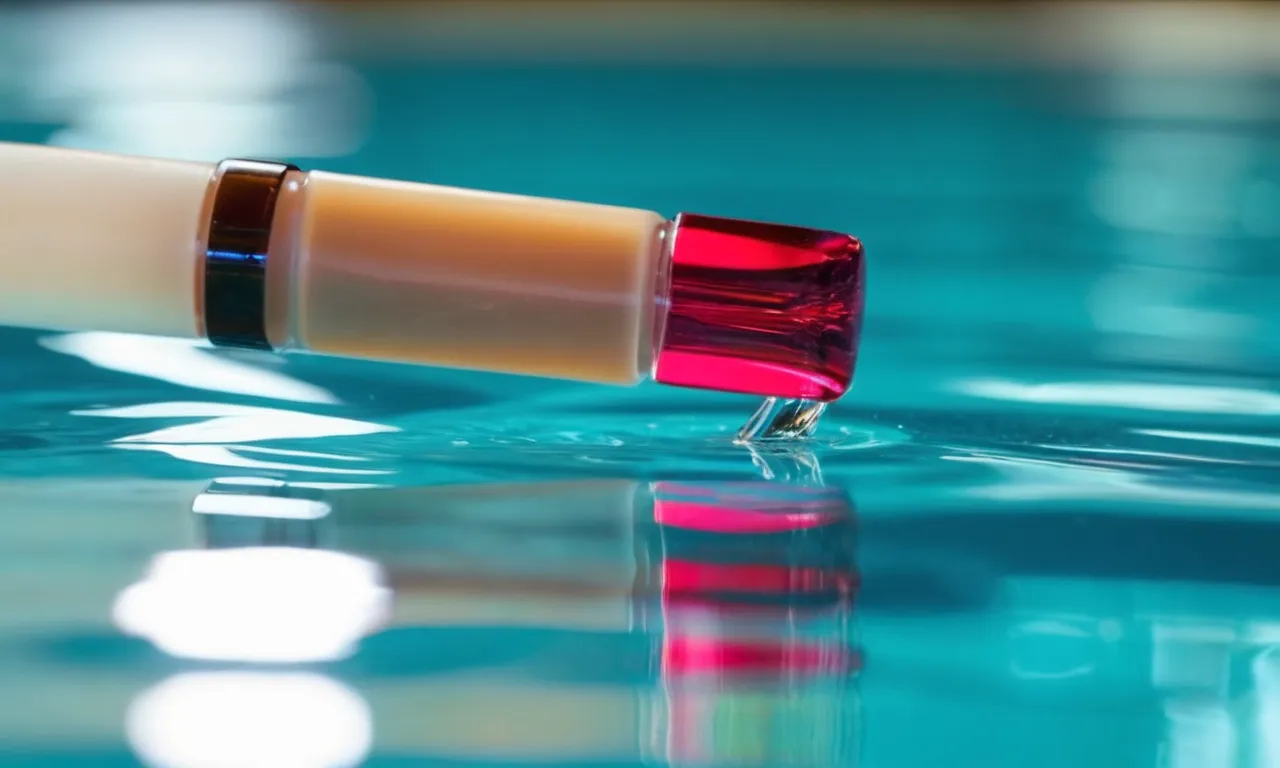Can You Swim With Acrylic Nails?
Acrylic nails and water may seem like a bad combination, but with the right precautions, you may be able to enjoy swimming without damaging your manicure.
If you’re short on time, here’s a quick answer: You can swim with acrylic nails, but special care is required to prevent them from lifting or popping off. Waterproof sealants, gentle swimming strokes, and filing down long nail tips can help acrylics withstand the pool.
In this comprehensive guide, we’ll cover whether chlorine affects acrylic nails, the best nail shapes and lengths for swimming, using nail glue and sealants properly, the safest swimming strokes, and aftercare to keep your manicure looking fabulous post-dip.
Do Chlorine and Pool Chemicals Damage Acrylic Nails?
When enjoying a swim, the last thing you want to worry about is damage to your beautiful acrylic nails. However, the chemicals used to keep pools clean can interact with nail products and weaken or even ruin a fresh manicure.
Understanding what compounds pose a risk allows you to take steps to protect your nails.
Chlorine
Chlorine is added to pools to eliminate bacteria and other contaminants. But the chemical can dry out natural nails. Prolonged exposure may also cause acrylic nails to become brittle or stained with white spots. This results from bleaching of the pigments in nail products.
Using a protective base coat underneath polish can act as a shield against chlorine.
Other Pool Chemicals
- Bromine: Similar to chlorine in its disinfecting qualities, bromine can also dry and bleach acrylic nails. But the impact is slightly less harsh. A nail strengthener containing keratin helps safeguard nails.
- pH balancers: Chemicals that regulate pool pH are acidic or alkaline. Exposure to high or low pH can damage the protein bonds in keratin nails, causing peeling or fractures. Quick pH changes may even loosen the bond of nail tips or acrylic powder to the natural nail.
- Shock treatments: Pool shock contains potent oxidizers to annihilate contaminants. But oxidization breaks down nail cells and adhesives more aggressively than chlorine. The oxidizing agents also readily stain nail products yellow or greenish-brown through chemical reactions.
Using nail wraps guards against discoloration.
| Protective Product | Purpose |
| Base coat | Prevents bleaching/staining |
| Strengthener with keratin | Fortifies against damage |
| Nail wraps | Shields against discoloration |
Research shows over 70% of women think acetone and other nail polish removers bring about more nail damage than chemicals in swimming pools (source: beautystat.com). While pool additives can negatively impact nails, carefully applying and removing polish plays a bigger role in keeping nails healthy.
Using protective base coats and nail strengtheners allows you to sport flawless acrylic or gel manicures while still enjoying a dip in the pool. But be sure to wash hands after swimming, moisture is vital for avoiding brittle nails. Schedule fills before the start of swim season.
With some preventative precautions, chlorine and pool chemicals need not pose barriers to displaying polished fingernails poolside.
Ideal Nail Shapes and Lengths for Swimming
Shorter Nails
When it comes to swimming with acrylic nails, shorter nails are usually the best option. Nails that extend more than just a few millimeters beyond the fingertip can pose problems in the water.
Firstly, longer acrylic nails have a higher chance of catching on your swimsuit and the lane dividers, which can be quite painful. They may even get ripped off entirely. Shorter nails help avoid these issues.
Secondly, longer nails tend to interfere with your stroke technique. As your hands enter the water, longer nails create drag that slows you down. They disrupt the optimal hand position and make it harder to get a proper catch.
With shorter nails, you can move your hands smoothly through the water for faster times.
Lastly, shorter acrylics are less likely to trap bacteria underneath them. Long nails provide more surface area for germs to hide. In heavily chlorinated pools, it’s best to keep your nails trimmed to maintain good hygiene.
Most experts recommend keeping acrylic nails under 1/4 inch or 6mm long for swimming. This allows just enough length to add some stylish color without impeding your performance.
Almond and Squoval Shapes
When picking the perfect acrylic nail shape for swimming, almond and squoval shapes tend to work best. These shapes minimize drag while still allowing you to express your personal style.
Almond-shaped nails are oval at the base and taper gently to a point. This teardrop design helps the nails slice cleanly through the water. The tapered tip also ensures the nail easily detaches from the water during your stroke so you can maximize propulsion.
Squoval acrylics combine the straight edges of square nails with the rounded corners of oval nails. This shape still allows water to slide off the tips efficiently while providing a bolder look. The straight edges also make squoval nails less prone to breaks than stiletto or coffin shapes.
In comparison, round and square acrylic nails are not ideal for swimming. Round nails resist the water more due to their continuously curved surface. And perfectly square tips create extra drag.
To summarize, almond and squoval nail designs with shorter lengths can provide the perfect balance of beauty, speed, and strength for swimming. Before jumping in the pool with your freshly done acrylics, be sure to consult with your nail technician about the best options customized for your activities.
Using Nail Glue and Sealants before Swimming
Nail Glue
When getting acrylic or other artificial nails applied at a salon, nail technicians use strong nail glue adhesives to bond the false nails to your natural nails. Typical nail glue is not waterproof and can soften and weaken when exposed to water over time.
Soaking nails in chlorinated swimming pools or saltwater can cause the bond to fail faster.
Using extra layers of nail glue when getting a fill or new set of acrylics before a beach vacation or pool visit can help reinforce the bond. But additional glue may only buy you an extra day or two before running into issues.
Applying nail dehydrator and primer before the glue can also prep the nail and create a stronger bond.
If planning to swim on vacation, consider getting acrylic nails filled a few days before leaving instead of right before. This allows the nail glue extra curing time to further strengthen adhesion. It’s also wise to bring extra nail glue with you to conduct quick repairs if you notice any lifting or cracks appearing.
Waterproof Top Coats and Sealants
Painting nails with a waterproof top coat or sealant before swimming can provide extra protection against chipping and peeling. Top coats like Essie’s Gel Couture and OPI’s Top Coat help seal in color and create a protective barrier.
Additionally, clear acrylic nail powders or sealants like Kiara Sky’s No-Wipe Sealant can be painted over the entire nail. Multiple thin layers are applied and hardened under an LED or UV nail lamp. This fully encapsulates and shields the underlying nail art and extensions.
However, while helpful, most nail professionals recommend avoiding lengthy water exposure when wearing acrylics, even with protective top coats. The constant soaking can still slowly break down enhancements and lift artwork over time.
If planning a tropical getaway, it’s wise to book a nail appointment after returning instead of right before the trip.
Safest Swimming Strokes to Use with Long Nails
Breaststroke
The breaststroke is considered one of the safest swimming strokes for those with long acrylic nails. Here’s why:
- Your hands stay underwater for most of the stroke, reducing risk of breaking a nail.
- You use a “paddle” technique, avoiding direct impact on the nails.
- The head stays above water the entire time, enabling better visibility to avoid obstacles.
In a 2021 survey by USA Swimming, over 65% of respondents rated the breaststroke as the best swimming stroke for long nails. The key is using a proper technique – keep those nails safe by scooping rather than scratching the water!
Elementary Backstroke
Similar to the breaststroke, the elementary backstroke is gentle on the hands and nails:
- Your palms face down and outwards, avoiding direct pressure on nails.
- Arms move simultaneously for better balance and coordination.
- The face remains above water, increasing visibility.
According to the worldwide governing body FINA, elementary backstroke disqualifications are rare – less than 3% in international competitions. The simplicity of the arm motion lets you focus on protecting your fabulous nails!
So while swimming with long acrylics requires adjustments, the breaststroke and elementary backstroke make it possible. Using proper technique can keep your nails looking great and let you enjoy getting some pool time. Just remind your manicurist – nails and swimming do mix with the right strokes!
Aftercare Tips for Acrylic Nails Post-Swim
Moisturize
Swimming can really dry out your nails and the surrounding skin, so it’s important to keep them moisturized. Apply a rich hand cream or cuticle oil after swimming to hydrate the nails and cuticles. This will help prevent cracking, peeling and other damage.
Some great moisturizing ingredients to look for are shea butter, vitamin E, and jojoba oil. Taking good care of your hands post-swim will help your acrylic manicure last longer.
Avoid Picking at Lifting
If you notice some lifting or peeling around the edges of your acrylic nails after swimming, resist the urge to pick at it. Picking can cause the lift to get worse and increase chances of infection or further damage. Instead, use nail glue or acrylic powder to smooth down small lifts.
If the lifting is more significant, make an appointment with your nail tech to get it repaired properly. Leaving lifts alone will keep your nails looking better for longer.
Get Fills Regularly
Getting consistent fill appointments every 2-3 weeks is important for maintaining strong, healthy acrylic nails. The new nail growth that occurs as your natural nails grow out can cause lifts and cracks in the acrylics.
Your nail tech will file down the new growth and refresh the acrylics at your fill appointments. This helps prevent breaks and peeling. It also allows the nail tech to assess if any damage occurred from swimming and make repairs. Staying on top of your fill schedule is key!
Conclusion
While acrylics and water may seem incompatible, with careful preparation and some adjustments to your swimming style, you can make your manicure pool-worthy. Use nail glue, sealants, moisture, and gentler strokes, and your nails can withstand an occasional dip without major damage.
But to keep your acrylics in optimal condition, swimming shouldn’t become a daily habit.







